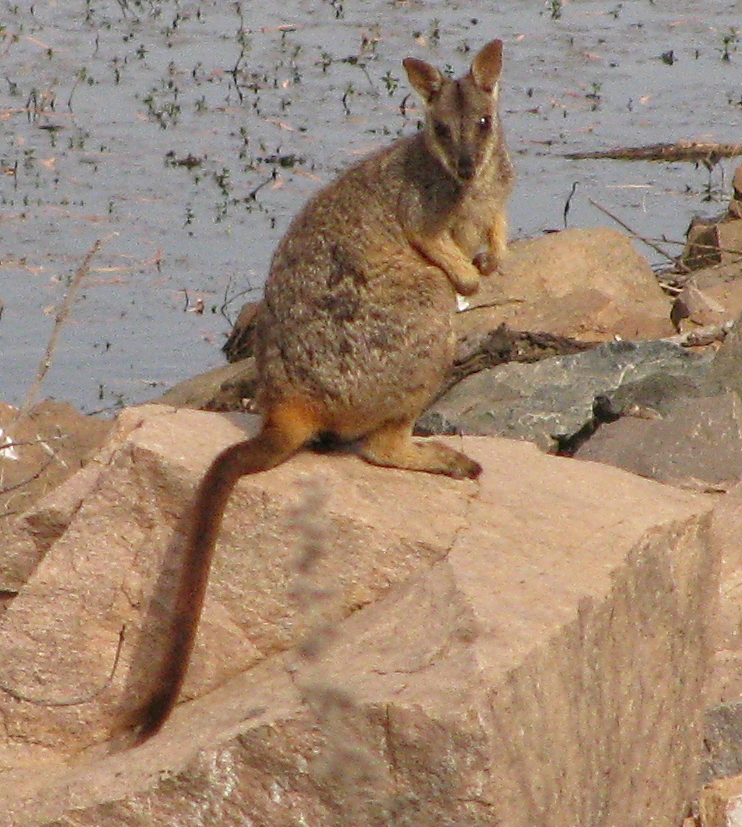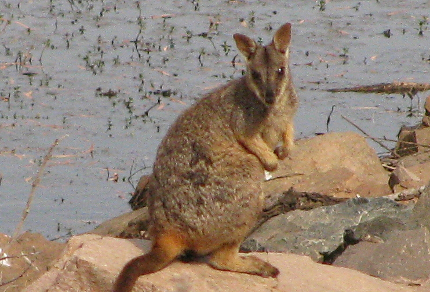Early this morning, Mount Stuart was caught in cloud, its towers spectres in the mist. Rain had fallen overnight, its remnants speckling the windshield as Vilis drove the Kia south through the city to Ross Lake, a vast reservoir caught behind the barrier of the Ross River Dam. On the car radio, we heard that resort islands near Port Douglas, north of Cairns, had been evacuated in preparation for the onslaught of Tropical Cyclone Olga. Warm north winds in Townsville whipped branches into wild motion and promised precipitation.
From the carpark in Ross Park, we hiked up a track on the bevelled and terraced outer grass slope of the Ross River Dam to its rim. The dam, which provides most of Townsville’s water supply and has greatly reduced flood damage to the city, is an average of 12 metres high and stretches for 8170 metres, a record for this type of construction in the Southern Hemisphere. This we learned from an interpretive sign.
The gravel road atop the dam’s rim separated the vista before us into two distinct worlds – the lake, with its wind-tossed, dull grey-green water below billowing clouds, and the plain, so green and level, with its open savannah woodland stretching westward to the base of forested peaks of Herveys Range. Behind us, to the north, the slopes of Mount Stuart were vivid green in the morning light, while in the distance to the southeast, thickly forested peaks brooded among grey curtains of rain and cloud.
Black kites floated on thermals above the dam, the medium-sized raptors dipping and soaring as though at play. A kite on the shoreline flapped to a dead tree and used a branch as a springboard, bouncing off it lightly to catch the wind. Then away it went, banking upward before hanging in the air.
Wind blasted us, and biting flies alighted on our shoulders and arms in droves, even with the wind. In the east, shafts of sunlight poured down through the clouds, lacing the lake with silver.
Pelicans floated on the lake’s waves like stately ships, and other fish-eaters abounded – a white-faced heron, a great egret with its regal and impossibly long neck, a couple of little egrets that flew overhead, a little pied cormorant onshore, and four chocolate-coloured hardhead ducks that bobbed on the waves. A great crested grebe held its prize of a captured fish in its beak, its wet crest of feathers resembling a Mohawk haircut. An Australasian darter, also called a snakebird or anhinga, perched on a rock on shore, its entire body one long, graceful flow from webbed, pink feet to narrow, stilletto beak. The darter was an adult male, its plumage black with flecks of white that made it look like it was spangled with silver.
I spotted sudden movement from an animal with a very different shape and pointed it out to Vilis. “Look! There’s a kangaroo-like animal running across the rocks!” Two macropods with skinny tails, rusty butts, and grizzled rust-and-grey pelages raced over the boulders with quick, short bounds. They were startlingly fast. When they stopped among the rocks, they stared at us with big, dark eyes, their small forelegs tucked against their chests. We figured they must be the rock wallabies we’d looked for on Mount Stuart yesterday.
We chalked up more sightings of snakebirds and wallabies while we walked 3 kilometres to a birding shelter at the end of an artificial spit. Most of the snakebirds were perched on rocks along the shore, some of them hanging their wings out to dry. Others scanned the water, their kinked necks waving like snakes preparing to strike. Vilis spotted one that was visible as no more than a thin, undulating neck and head protruding from the water – hence the name ‘snakebird.’
Our wallaby search image also sharpened. We spotted a total of 8 of the fuzzy hoppers, some entirely visible with their big hind feet braced atop boulders; others only displaying heads and ears or upper bodies above rock cover. All seemed highly inquisitive, staring at us intently until Vilis raised his arms. Then they burst into motion, speeding across the boulder slope.

Allied Rock Wallaby at Ross River Dam, Townsville (© Magi Nams)
After our return to the car, I checked my mammal guide, which informed me that seven species of rock wallabies that are virtually indistinguishable in the field inhabit the east coast of Queensland from Cape York to near the New South Wales border.1 None of the illustrations in the guide were dead ringers for the critters we saw, but my best guess, based on geographic range, was the allied rock wallaby. It was a pleasant irony that, while we came to the dam looking for birds, our most exciting find was something entirely unexpected – the wallabies.
Reference:
1. Peter Menkhorst and Frank Knight. A Field Guide to the Mammals of Australia. 2004. Oxford University Press, South Melbourne, Victoria. pp. 134-135.


